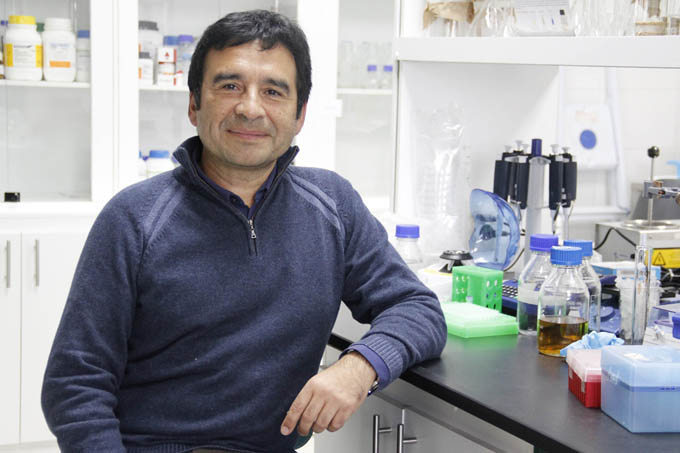News
Reveal existence of sea areas lacking oxygen in oceans of Chile and Peru
Published 05-10-2012
Thank mainly results from the application of technology in Chilean waters, an international scientific team led by a researcher at the Department of Oceanography and Center UdeC FONDAP Cups, Osvaldo Ulloa, entregó una nueva visión de cómo funcionan las zonas deficientes de oxígeno en ambientes marinos, como las que se encuentran frente a las costas del norte de Chile y Perú.
La existencia y funcionamiento de zonas anóxicas en el océano abierto global son descritas en el artículo Microbial oceanography of anoxic oxygen minimum zones , publicado en la sección Perspective de la prestigiosa revista internacional Proceedings of the National Academy of Sciences, PNAS .
Esta contribución ha sido posible, partly, gracias a la utilización de técnicas súper sensibles, de gran poder de resolución, que se han desarrollado y aplicado en el marco de investigación realizada en aguas chilenas, y que actualmente todavía no están disponibles en el mercado. This is explained by DR,es,Ulloa,en,Thanks to the developed technological advance,es,Today we can measure oxygen with a much greater sensitivity and product of this is that we have been able to determine,es,first of all,es,The existence of extensive anxic areas in the open ocean,es,They have nothing oxygen,es,This was an argument that we had with enough colleagues because,es,There was no certainty that it was,es,And there is a big difference between that there is very little oxygen or that there is nothing,es,particularly for microbial processes,es,This publication,es,Add the oceanographer,es,Synthesizes the results of several years of work and allows you to take a new look at this topic,es,and therefore it is published in this section of the magazine,es. Ulloa: “gracias al avance tecnológico desarrollado, hoy podemos medir oxígeno con una mucho mayor sensibilidad y producto de ello es que hemos podido determinar, en primer lugar, la existencia de extensas zonas anóxicas en el océano abierto; namely, que no tienen nada de oxígeno. Esta era una discusión que teníamos con bastantes colegas porque, a nivel mundial, no había certeza de que así fuera, y existe una gran diferencia entre que exista muy poco oxigeno o que no exista nada, en particular para los procesos microbianos”.
Esta publicación, agrega el oceanógrafo, sintetiza los resultados de varios años de trabajo y permite dar una nueva mirada a este tema, y por ello se publica en esta sección de la revista, where it is possible to deliver perspectives and propose hypotheses in this area,es,To talk about this discovery,es,Scientists coined a new term,es,Marine anxic areas,es,ZAM,en,to differentiate them from the minimum oxygen areas,es,Zmo,lt,described in various areas of the ocean,es,Another relevant aspect discovered thanks to the use of another cutting -edge technology -as are the autonomous profilers,es,the thing is,es,occasionally,pt,This anxic system is disturbed by oxygen injections,es,something that had never been observed before and about which it is not yet known what its nature or impact is,es,A few years ago,es,The same scientific team determined that in Las Zam there is an active sulfur cycle,es.
Para hablar de este descubrimiento, los científicos acuñaron un nuevo término, Zonas Anóxicas Marinas (ZAM)- para diferenciarlas de las Zonas de Mínimo Oxígeno (ZMO), descritas en diversas áreas del océano.
Otro aspecto relevante descubierto gracias al uso de otra tecnología de punta -como son los perfiladores autónomos- es que, ocasionalmente, este sistema anóxico es perturbado por inyecciones de oxígeno, cosa que nunca antes se había observado y acerca de la cual aún no se sabe cuál es su naturaleza o impacto.
Hace unos par de años, el mismo equipo científico determinó que en las ZAM existe un ciclo activo del azufre, something unexpected according to environmental microbiology texts,es,According to the scientist,es,Until this discovery it was not thought that the microbial activity associated with the sulfur cycle could occur in open waters of the ocean with low oxygen content and nitrate presence,es,In the work published in PNAS we perform an analysis and propose a new conceptual model or scheme of how this regions would be working,es,And what are the microbial processes that are being carried out within the Zam,es,It was known that within the Zam there was an active nitrogen cycle,es,But the contribution of our research group is that there is also an active sulfur cycle,es. Según el científico, hasta este descubrimiento no se pensaba que la actividad microbiana asociada al ciclo del azufre pudiera ocurrir en aguas abiertas del océano con bajo contenido de oxígeno y presencia de nitrato.
“En ese contexto, en el trabajo publicado en PNAS realizamos un análisis y planteamos un modelo o esquema conceptual nuevo de cómo estarían funcionando esta regiones, y cuáles son los procesos microbianos que se están llevando a cabo dentro de las ZAM. Por ejemplo, se sabía que dentro de las ZAM había un ciclo activo del nitrógeno, pero el aporte de nuestro grupo de investigación es que también existe un ciclo activo del azufre, And this was evidenced by applying both modern and geochemical genomic techniques,es,This discovery gave light on the existence of a relationship between these ZAM and interior anoxic seas,es,Like the Black Sea,es,as well as oceans in the past,es,Existing microorganisms and the processes that are carried out in the ZAM are similar to those existing in anoxic systems that accumulate sulphogenic hydrogen,es,H2s,eo,A highly toxic gas,es,Until now it was thought that they worked differently,es,In this way,es,We propose that the ZAM represent an intermediate state between a completely oxygenated ocean and a completely anxic with high H2S accumulation,es,Somehow,es,Ulloa holds,es”, explica.
Este descubrimiento dio luces sobre la existencia de una relación entre estas ZAM y mares anóxicos interiores, como el Mar Negro, así como océanos en el pasado. “Los microorganismos existentes y los procesos que se llevan a cabo en las ZAM son similares a los existentes en sistemas anóxicos que acumulan hidrógeno sulfurado (H2S), un gas altamente tóxico; hasta ahora se pensaba que funcionaban distinto. De tal modo, proponemos que las ZAM representan un estado intermedio entre un océano completamente oxigenado y otro completamente anóxico con alta acumulación de H2S, como el Mar Negro”, señala.
De alguna manera, sostiene Ulloa, This is related to how the ocean could have been in the past,es,We know that there were periods of history where the ocean had no oxygen,es,accumulated H2S,es,and great extinctions occurred,es,With this discovery we can say that the processes that are carried out and the microorganisms that are present in these anxic systems,es,They could also be present in the past,es,allowing us to understand how the oceans worked in those times,es,This assertion acquires importance today,es,especially due to the global warming process that causes the ocean to lose oxygen,es,This leads to waiting for,es,Towards the future,es,These anxic areas expand and that in some of them,es,H2S begins to accumulate,es. “Sabemos que hubo periodos de la historia donde el océano no tuvo oxígeno, acumuló H2S, y se produjeron grandes extinciones. Con este descubrimiento podemos decir que los procesos que se llevan a cabo y los microorganismos que están presentes en estos sistemas anóxicos, también pudieron estar presentes en el pasado, permitiéndonos entender cómo funcionaron los océanos en esas épocas”, says.
Esta aseveración adquiere importancia en la actualidad, sobre todo debido al proceso de calentamiento global que provoca que el océano pierda oxígeno. Ello lleva a esperar que, hacia el futuro, estas zonas anóxicas se expandan y que en alguna de ellas, incluso, se empiece a acumular H2S, as in the Black Sea,es,Until now it was not thought that there could be anxic areas in open sea,es,less so close to the surface,es,Like what was observed in front of the Chilean coast,es,Ulloa explains that this occurs due to the combination of circulation and high surface productivity,es,These are sub-superficial waters that arrive in this region after a long trip,es,They are older waters,es,The only way in which seawater obtains oxygen is because it has been on the surface,es,By exchange with the atmosphere or by photosynthesis,es,Once this water sinks, it has no how to gain oxygen,es,The largest amount of oxygen is on the surface,es.
Hasta ahora no se pensaba que pudieran existir zonas anóxicas en mar abierto, menos tan cercanas a la superficie, como lo que se observó frente a las costas chilenas. Ulloa explica que esto se produce debido a la combinación de circulación y alta productividad en superficie.
“Se trata de aguas sub-superficiales que llegan a esta Región tras un largo viaje. Son aguas más viejas. La única manera en que el agua de mar obtiene oxígeno es porque ha estado en la superficie, por intercambio con la atmósfera o por fotosíntesis. Una vez que esta agua se hunde no tiene cómo ganar oxígeno. Por eso, la mayor cantidad de oxígeno está en la superficie. The waters that make up the Zam sink and begin to travel far from where they are currently,es,and in the case of the South Pacific,es,instead of passing directly from south to northern Chile,es,Take a long turn,es,The waters that arrive here in the north have been like,es,years without contact with the atmosphere,es,Ulloa explains,es,Upon reaching Chilean coasts -which have great productivity,es,These waters,es,that they already come with little oxygen,es,They find a large amount of organic matter that,es,When breathed,es,ends up consuming the oxygen they have left,es,The researcher points out that Zam lose nitrogen due to microorganism activity,es,since there are no oxygen breathe nitrogen compounds,es,What decreases sea fertility,es, y en el caso del Pacífico Sur, en lugar de pasar directamente del Sur al Norte de Chile, dan una vuelta larga. Entonces, las aguas que llegan aquí por el Norte han estado como 30 años sin contacto con la atmósfera”, explica Ulloa.
Al llegar a las costas chilenas -que tienen gran productividad- estas aguas, que ya vienen con poco oxígeno, se encuentran con una gran cantidad de materia orgánica que, al ser respirada, termina por consumir el oxígeno que les queda.
El investigador señala que las ZAM pierden nitrógeno por la actividad de microorganismos, ya que al no haber oxígeno respiran compuestos nitrogenados, lo que disminuye la fertilidad de mar. “If these areas begin to expand more,es,The ocean will lose more nitrogen,es,More fertilizer,es,What we must worry about is to understand how microorganisms work,es,since the fish start from these areas,es,There are some who have the ability to immerse and endure,es,But it is the microorganisms that make the system work,es,They are also those that produce greenhouse gases that are released in large quantity in these areas,es,By giving a new look at the ZMO and determining the existence of anxic areas,es,This knowledge is expected to generate better predictive models about what can happen to these areas and make more realistic projections,es,By offering a new understanding,es,This will allow us to make better predictions,es, el océano va a perder más nitrógeno, más fertilizante. De lo que debemos preocuparnos es de entender cómo funcionan los microorganismos, ya que los peces arrancan de estas zonas; hay algunos que tienen la capacidad de sumergirse y aguantar, pero son los microorganismos los que hacen funcionar el sistema, además son los que producen los gases invernaderos que se liberan en gran cantidad en estas zonas”, says.
Al dar una nueva mirada a las ZMO y determinar la existencia de zonas anóxicas, se espera que este conocimiento sirva para generar mejores modelos predictivos sobre qué puede pasar con estas zonas y hacer proyecciones más realista. “Al ofrecer un nuevo entendimiento, esto nos permitirá realizar mejores predicciones. Especially considering that there were periods in which the oceans were oxygenated and became anoxic,es,what was associated with mass extinctions,es,That is important to take it into account,es,If we are going to disturb the system so much with human activity,es,It is necessary to know what can happen,es,In Ulloa's opinion,es,The publication of this article in PNAS represents a recognition of work,es,To the team,es,to the research group,es,This is a clear example of what is done in Chile in Oceanography,es,especially the level that the UdeC has reached in this area,es,This research has a global impact but,es,It is a problem that directly affects us since it is a phenomenon that is on our coasts,es,Osvaldo -ooa-3,es, lo que estuvo asociado con extinciones masivas. Eso es importante tenerlo en cuenta. Si vamos a perturbar tanto el sistema con la actividad humana, es necesario saber qué puede pasar”, sostiene.
A juicio de Ulloa, la publicación de este artículo en PNAS representa un reconocimiento al trabajo, al equipo, al grupo de investigación. “Este es un ejemplo claro de lo que se hace en Chile en oceanografía, sobre todo el nivel que ha alcanzado la UdeC en esta área. Esta investigación tiene impacto mundial pero, at the same time, es un problemas que nos afecta directamente ya que se trata de un fenómeno que está en nuestras costas”, concluye.



